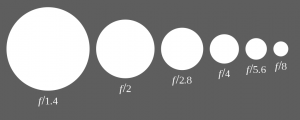In photography, aperture is the hole within a lens that light travels through to reach the image sensor. The larger the hole, the more light passes to the camera sensor. The aperture is typically expressed in “f” numbers, also known as the “focal ratio.” The f-number is the ratio of the diameter of the lens aperture to the length of the lens. Increasing or decreasing your aperture one stop results in a change in the “f” number by a factor of the square root of two (around 1.4). Why this value? If you double the amount of light passing through a circular hole over the same time interval, the circle’s area needs to increase by a factor of 2. What factor do you multiple the diameter to double the area of a circle? The square root of 2.
What is the best aperture to use for bird photography? Any value that gives you more depth of field than the bird and any other object you want in focus (e.g., water reflection). The depth of field is the area of your image that is in focus and is the distance between the nearest and the farthest object that are in focus. The shallowness of the depth of field depends on the aperture; the focal length of the lens; the size of the camera sensor; and distances between you, the subject and the background.

“Aperture diagram” by Cbuckley is licensed under GNU Free Documentation License, Version 1.2 or any later version published by the Free Software Foundation.